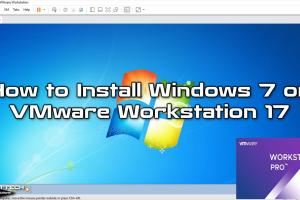Step-by-Step Guide to Installing Windows 7 on VMware Workstation

-
Quick Links:
- Introduction
- Prerequisites
- Downloading Windows 7 ISO
- Installing VMware Workstation
- Creating a New Virtual Machine
- Configuring VM Settings
- Installing Windows 7
- Post-Installation Setup
- Troubleshooting Common Issues
- Conclusion
- FAQs
Introduction
Virtualization has transformed the way we use operating systems on our computers. One of the most popular virtualization software is VMware Workstation, which allows users to run multiple operating systems on a single physical machine. This guide will walk you through the process of installing Windows 7 on VMware Workstation, providing you with a virtual environment to test applications or perform tasks without affecting your primary operating system.
Prerequisites
Before you begin the installation process, ensure you have the following:
- A computer with at least 4GB of RAM (8GB recommended).
- VMware Workstation installed on your machine.
- A valid Windows 7 ISO file.
- At least 20GB of free disk space for the virtual machine.
Downloading Windows 7 ISO
To install Windows 7, you first need to download the ISO file. You can obtain this from various sources:
- Official Microsoft website - If you have a valid product key.
- Third-party sites like TechSpot or Internet Archive.
Make sure to verify the integrity of the downloaded ISO to prevent installation issues.
Installing VMware Workstation
Your next step is to install VMware Workstation. Follow these steps:
- Download the latest version of VMware Workstation from the official VMware website.
- Run the installer and follow the on-screen prompts. Accept the license agreement and choose the installation location.
- Once installed, launch VMware Workstation.
Creating a New Virtual Machine
Now that you have VMware Workstation installed, it's time to create a new virtual machine:
- Open VMware Workstation and click on "Create a New Virtual Machine."
- Select "Typical (recommended)" and click "Next."
- Choose "Installer disc image file (iso)" and browse for your Windows 7 ISO file. Click "Next."
- Select the guest operating system as "Microsoft Windows" and version as "Windows 7." Click "Next."
- Name your virtual machine and choose a location to save it. Click "Next."
- Allocate the disk space (at least 20GB recommended) and choose whether to store the virtual disk as a single file or split into multiple files. Click "Next."
- Review your settings and click "Finish."
Configuring VM Settings
Before proceeding with the installation, you may want to configure some additional settings for your virtual machine:
- Go to "Edit virtual machine settings."
- In the "Hardware" tab, you can adjust the amount of RAM, number of processors, and network settings according to your needs.
- Ensure that the CD/DVD drive is connected to the ISO file for installation.
Installing Windows 7
With your VM configured, it's time to install Windows 7:
- Start the virtual machine by clicking the "Power on this virtual machine" button.
- Follow the on-screen prompts to begin the installation process. Select your language, time, and keyboard preferences, then click "Next."
- Click "Install now" and accept the license terms.
- Select "Custom (advanced)" installation.
- Choose the partition where you want to install Windows and click "Next."
- Wait for the installation to complete. Your VM will restart several times during this process.
Post-Installation Setup
Once Windows 7 is installed, follow these steps for setup:
- Create a user account and set your password.
- Customize your settings (e.g., choose to enable Windows Update).
- Install VMware Tools to enhance performance and usability. Go to "VM" > "Install VMware Tools" and follow the prompts.
Troubleshooting Common Issues
If you encounter issues during installation, consider the following:
- Ensure your ISO is not corrupted.
- Check your system requirements and VM settings.
- Look for specific error messages and search online for solutions.
Conclusion
Installing Windows 7 on VMware Workstation is a straightforward process that allows you to utilize this operating system in a virtual environment. Whether for testing, development, or learning purposes, following this guide will help you set up your virtual machine efficiently.
FAQs
- 1. Can I install Windows 7 on VMware Workstation for free?
- VMware Workstation offers a free trial, but you will need a license for extended use. Windows 7 requires a valid product key for installation.
- 2. What are the system requirements for running Windows 7 on VMware?
- A minimum of 2GB of RAM is required, but 4GB or more is recommended for better performance.
- 3. How do I enable network access for the virtual machine?
- In the VM settings, under the "Network Adapter" section, ensure that it is set to "NAT" or "Bridged" depending on your network requirements.
- 4. Can I run multiple virtual machines simultaneously?
- Yes, as long as your host computer has enough resources (CPU, RAM) to support multiple VMs.
- 5. What should I do if Windows 7 does not recognize my hardware?
- Ensure that you have installed VMware Tools, which provides drivers for better hardware compatibility.
- 6. How can I increase the disk space for my virtual machine?
- You can increase the disk space by editing the virtual machine settings or by using third-party tools to expand the virtual disk.
- 7. Is it safe to use Windows 7 in a virtual machine?
- Yes, but keep in mind that Windows 7 is no longer supported by Microsoft, which may expose you to security risks.
- 8. Can I use USB devices in my virtual machine?
- Yes, you can connect USB devices by enabling the USB controller in the VM settings.
- 9. How do I uninstall a virtual machine?
- Right-click on the virtual machine in VMware Workstation and select "Remove" to delete it from your library.
- 10. What are the advantages of using VMware Workstation?
- VMware Workstation allows you to run multiple operating systems, test software, and create snapshots for easy recovery.
Random Reads